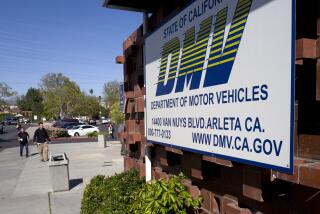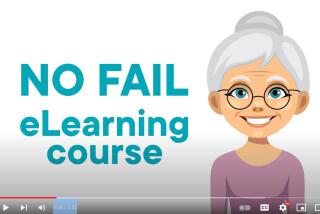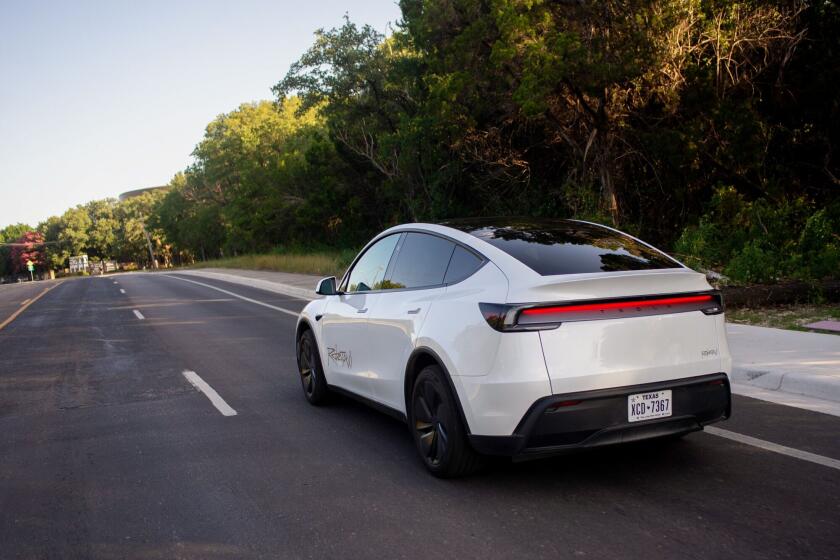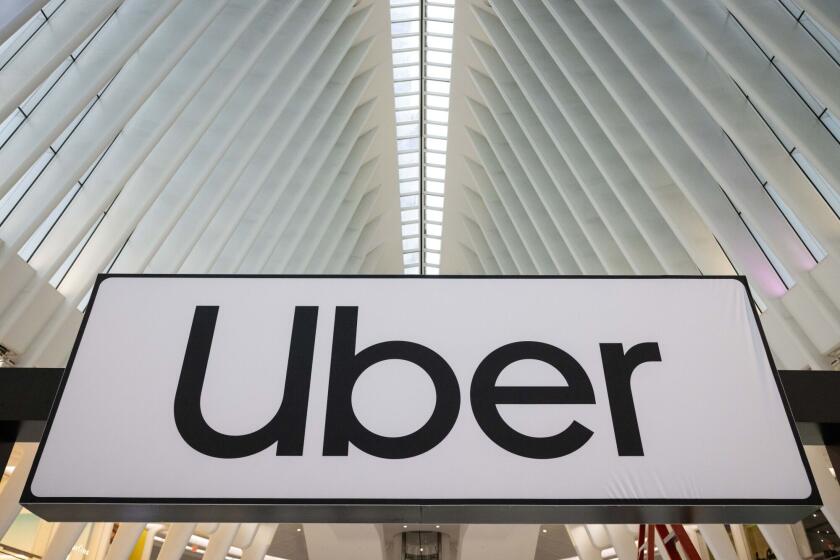Licenses Take a Back Seat
- Share via
Like most of her classmates at Laguna Hills High School, Kayte Greenfelder took driver’s education at 16. She sat through the grainy old death-on-the-asphalt movies, memorized the handouts on rights-of-way and traffic signals, even went to the Department of Motor Vehicles and got a learner’s permit.
Somehow, though, she never got around to actually getting her license. “I guess I was lazy -- plus, I couldn’t afford the insurance, and standing in line at the DMV just felt like a big hassle,” said Greenfelder, who at 19 still isn’t driving.
But wasn’t it embarrassing, year after year, being the only kid in the subdivision still bumming rides from her mother? Not really.
“I knew probably 20 other people just like me.”
Getting a driver’s license at 16 has long been a rite of passage. The learner’s permit at 15, the hair-raising driving practice with the shrieking parent, the dreaded clipboard guy at the DMV administering the road test, the first sobering crash involving a classmate -- for better and worse, the rush for the license is so culturally enshrined that its particulars verge on cliche.
But quietly, while the adults weren’t looking, kids have stopped driving at 16 the way they used to. In a shift that has overtaken the culture virtually without notice, a confluence of forces has redefined the concept of “driving age.”
Poorer young people, tougher licensing laws, shifting teen attitudes, protective baby boom parents, soaring auto insurance premiums -- these and other factors appear to have conspired to keep not just most 16-year-olds, but more teens of all ages from driving.
Only 43% of all 16- and 17-year-old Americans were licensed in 2002, the last year for which statistics were available, according to the Federal Highway Administration and U.S. Census Bureau. In 1992, that figure was nearly 52%. Meanwhile, in supposedly car-addicted California, teens are even less likely to be driving. Slightly less than 27% -- about 1 in 4 -- of the state’s 16- and 17-year-olds were licensed last year, a figure that has been sliding since at least 1978, when it was 50.1%.
Yet for all its size, the phenomenon has largely eluded the cultural radar, even as it has left parents privately commiserating about kids who need to be chauffeured long after they’ve graduated from high school. Politicians still call for crackdowns on the supposed legions of reckless teen drivers. TV shows such as “The O.C.” routinely depict teens driving. Pop and hip-hop songs about cars still get the level of airplay the Beach Boys did back when teens lived in fear that Daddy might actually take the T-Bird away.
This is in part because cars are still a big deal. Even with lowered proportions of young drivers, millions of adolescents remain on the freeways, and traffic crashes still are the leading cause of death for 15- to 20-year-olds.
But it also may be because, as trends go, the decline in licensing has been slow speed and has reached critical mass only in the last decade. Raymond Peck, a Folsom-based traffic safety consultant who was chief of the California DMV’s research and development branch until 2000, said the declining numbers had generally been regarded as an intriguing footnote to more pressing research on the effects of various traffic safety measures. “I’m not sure anyone in California has been aware of it except for a few people at the DMV.”
In any case, it is making itself felt in places like suburban Orange County, where Manako Ihaya, a mother of four, recently bought a sporty red Honda in an attempt to entice her 18- and 20-year-old daughters to get licensed. So far, she said, they’ve ignored the bribe.
“As soon as I turned 16, I got my license,” remembered Ihaya, who was born in Japan and grew up in the San Gabriel Valley. “If you didn’t, it would have been like, ‘What’s wrong with you?’ ”
In Riverside, 16-year-old Kevin Wintersteen says he’d like a license, but he keeps hitting roadblocks.
“First, we didn’t have the money for driving classes. Then we got the money, but on the day they had the classes, I had football practice and I didn’t want to miss,” he said. “Then I found this online class. And we sent $85 and they sent all this stuff. But then our Internet got messed up and it took three or four weeks for it to come back. Then the test you had to take to pass the class was pretty long, and each chapter was like 20 or 30 questions, and I was just doing a chapter, like, every now and then. And then when I finished it? We couldn’t find an envelope ... “
Doing without, however, hasn’t been as painful as he’d expected, the boy said. His mom drops him off every morning at his school’s entrance, and his girlfriend, who is 18, provides the transportation when he goes out.
In urban Los Angeles, Garfield High School football coach Lorenzo Hernandez recently bought an SUV to shuttle players because so many lacked transportation. “It’s amazing,” Hernandez said. “It used to be if kids needed rides, there were seniors or whoever who could take them. But we have 56 kids on the team this year, and I only have, like, two who can drive.”
Don Hastings, a retiree who began teaching driver’s training in 1955 in the Los Angeles school system and who oversees what’s left of Garfield’s education elective, believes that’s “probably a good thing. The kids are pretty immature nowadays.”
In fact, concern over maturity and safety were behind two of the most recent deterrents to teen driving -- the decline of school-based driver’s training and the imposition in many states of so-called graduated licensing.
Many teens, though, add at least one more reason: They’re just not in a hurry to burn rubber. Taught from toddlerhood to express their feelings, some say they feel freer to resist a transition for which they don’t feel ready.
“I was a little scared,” confessed Erin Phillips, 18, of Laguna Hills, who waited two years to get her license, though it meant her mom had to drive her to and from her part-time job at a mall two miles away in Mission Viejo. “I kept picturing the worst possible things.”
“There’s a fog of misperception, shared by virtually every adult in this country, that every 16-year-old wants a license,” said Rob Foss, senior research scientist at the University of North Carolina Highway Safety Research Center.
Foss, who studied licensure rates among North Carolina teens in the mid-1990s, found that many didn’t drive simply because they weren’t interested yet in learning or lacked confidence.
Take Aarinn Cates. She’s almost always in need of a ride somewhere. Nineteen and unlicensed, Cates, who moved from California to Florida during high school, says she hasn’t gotten around to getting a license because “I don’t have time.”
“When I was in high school, I had too many other classes, and the private driver’s training was priced too high,” said the teen, who lives in Bradenton, Fla. “When I moved, the school I moved to didn’t allow cars because there was too much drag racing, but nobody was in a rush to drive here either.”
Now, she says, her parents shuttle her to her job as a supermarket bakery clerk and will probably drive her to the community college where she is set to start classes next year. Her mother says she doesn’t mind: “We sheltered our kids quite a bit, and I personally don’t feel they need to be out there.”
Aarinn’s brother, who is 16, has been told he can’t learn to drive until she does. Other than his impatience, she says, the only pressure she feels is the occasional red-faced moment. “Sometimes it’s embarrassing because you see a cute guy driving his own car, and there you are being dropped off by, like, your mom.”
The road to a driver’s license wasn’t always daunting. As recently as a generation ago, even the strictest states required little more than 30 hours of driver’s education in a public school classroom -- taught as often as not by one of the coaches -- half a dozen hours behind the wheel under adult supervision and a passing score on a driving test.
But driver’s education became a target during the 1980s, after a series of studies indicated that teens who took the then-mandatory courses had roughly the same accident rates as those who didn’t. Federal subsidies dried up and, one by one, states phased the programs out.
Now, according to a USA Today survey conducted last year, only about half the states provide any funding for driver’s ed in high school, and in nearly all of those states, school district participation is voluntary. In California, some public schools still offer classroom driver’s education as an elective, but free hands-on high school driver’s training has been eliminated almost entirely.
In its place, states in the 1990s began adopting graduated licensing, which sharply increased the time and financial commitment in getting a license while restricting driving privileges for those younger than 18.
In California, for instance, a 16-year-old is required to spend six months with a learner’s permit and receive both driver’s ed and 50 hours of supervised driving practice before applying for a license. With public driver’s ed all but extinct, most students find themselves forced to pay for private instruction, an investment that can cost hundreds of dollars per student at a driving school.
Then, even if the 16-year-old passes the driving test, the resulting provisional license will restrict him or her from carrying other teenagers without adult supervision and from being on the road after midnight. Not much of a payoff for such a hefty investment, many teens say.
But those changes don’t explain the fact that licensure rates are declining for all young drivers, not just the graduated licensing crowd under 18. Nor do they fully explain the generation-long drop-off in California.
“I don’t think anybody really knows for certain why it’s happening,” said Allan Williams, chief scientist at the Insurance Institute for Highway Safety in Arlington, Va. However, sociologists who have begun to study the phenomenon have some strong suspicions, starting with the many ways that life has changed for this generation of American teens.
UC Santa Cruz sociologist Mike Males, who has written extensively on social trends involving young people, thinks it’s about money. “Cars are expensive and expensive to insure,” he said.
In California, child poverty rates have shot up dramatically during the years in which licensure rates have fallen, Males said. In 1980, 1 in 10 of the nation’s poor children lived in California; by 2000, it was 1 in 6, according to the National Center for Children in Poverty.
Meanwhile, the price of auto insurance, both here and nationally, has pressed higher. The National Assn. of Insurance Commissioners reports, for example, that auto insurance rose on average from $637 per vehicle in 1993 to $774 in 2002, the last year for which data are available. Because crash risk rises with inexperience, adding a teen driver further ups the ante, typically doubling or even tripling the premiums on a family policy.
Economics certainly factor into it for Steven Shephard, a 17-year-old senior at Ramona High School in Riverside. Like most public schools, Ramona long ago stopped offering driver’s education, and when Shephard found out he’d have to pay for private instruction, the handwriting was on the wall.
“Those classes are 200-something bucks, and I don’t have the money,” Shephard said. He could have gotten a part-time job, he said, but with his build (“I’m 6-foot-5”), he decided instead to put all his energy into football, hoping to win a college scholarship.
The strategy has meant walking to school in the morning, bumming rides home with his friends and tagging along with a carload of other people if he wants to go out on weekends. But Wintersteen, his teammate, says plenty of kids are wheel-less: “I’m a junior, and I’d say the majority in my class don’t drive.”
Some teens, in fact, say you couldn’t pay them to start driving.
“I think it must be a mental block,” said Manako Ihaya’s 18-year-old daughter, Hana, who hasn’t even turned over the ignition in the Honda her mother bought in hopes she and her sister might hit the road. “The more I hold back, the more pressure I feel, and the more pressure I feel, the more I hold back.”
Why? She’s not sure. Maybe it’s in her nature. Or maybe all those policies aimed at dangerous teen driving have finally worked -- too well.
“Maybe it was those videos they showed us from the 1960s in driver’s training, with the exploded heads and the guts all over the road,” she giggled. “I mean, how’s that supposed to help? Ewww!”
*
(BEGIN TEXT OF INFOBOX)
Least likely to burn rubber
The percentage of U.S. teens ages 16 to 17 with driver’s licenses fell from 54% in 1982 to 43% in 2002.
U.S population 16 or 17 years old
1982: 7,773,000
1992: 6,757,000
2002: 8,157,000
16 or 17 years old with driver’s license
1982: 4,177,000
1992: 3,500,000
2002: 3,497,328
Sources: U.S. Census; Federal Highway Administration
More to Read
Sign up for Essential California
The most important California stories and recommendations in your inbox every morning.
You may occasionally receive promotional content from the Los Angeles Times.












